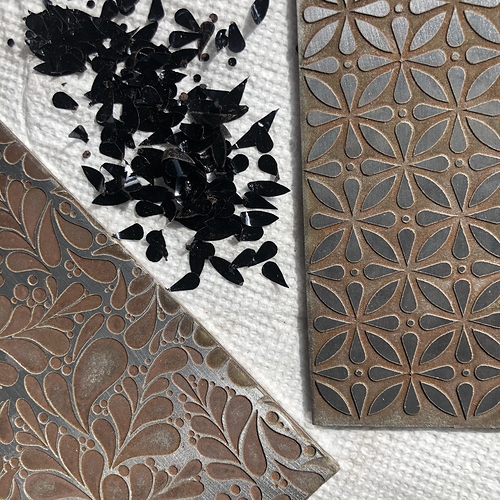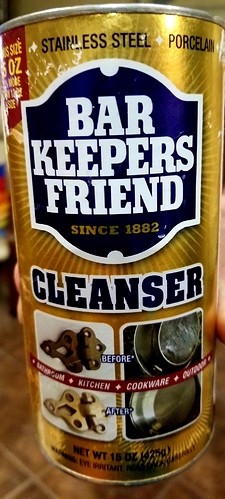Hi all - I am learning how to make my own steel texture plates with some success, but I could use some help with the final stage - cleaning off the lingering rust.
I created patterns with vinyl resist, and I am etching with copper sulphate, salt, and water, using a small fish tank pump to keep the water moving. I just finished two more last weekend, and the rust in the indentations is pretty pronounced - I am worried the metal will not be smooth when I run it through the rolling mill.
You can see some additional photos at http://www.instagram.com/ndhanthro if you’re interested.
Any suggestions? Ideally something that’s not super toxic (and therefore relatively easy to dispose of).
There are various commercial products to remove rust…generically this stuff used to be called naval jelly. There are even videos on You tube that show comparisons between Coca-cola, vinegar and various products like Krud Kutter (did well) and Evapo-Rust (didn’t).The problem seems to be that removing the rust will still leave a matte surface where the corrosion ate into the metal and will also probably leave your nice unetched surfaces also somewhat slightly pitted.Of course, you can easily sand off the raised surfaces while still leaving the recessed areas a bit matte, and that is probably what I would do. I would first try a plate as it is now…the plate on the right has a nice uniform rusted matte surface and you might like this. I think that short of laboriously polishing all of the recessed areas by hand, it’s going to be hard to get everything polished. Brass plates don’t last as long, but seem to be available completely polished. They are probably stamped out from polished dies. I’m afraid that etching is always going to leave a somewhat matte surface, being an eating away process, but I can’t say I know this from experience. Hope some of this is helpful…for what it’s worth, in the video I saw, Krud Kutter seemed to leave a pretty smooth surface after 5 minutes of rust removal on very rusted nuts and bolts, so maybe the surface will be smoother with your minor amount of rust. I’d be careful about what I put myself through in removing the rust that could be used as a design element, because then you also have to oil your plates and store them very carefully to keep them from rusting again, etc., etc. -royjohn
3 Likes
Welcome!
Because you had salt in your etching formula, that is probably where the rust came from. You may want to scrub them very well with soap and water, dry them and If you can, could you use a wire brush and a light oil and scrub off the rust? Brass is softer than steel so I would think there would be no scratches. Also, it would be best to keep a thin coat of light oil on these at all times to stop the oxidation. Best of luck
1 Like
you can also do reverse electrolysis
1 Like
I just cleaned one of my cold rolled steel plates with Bar Keepers Friend, a light scouring powder which has oxalic acid to reduce the ferric oxide rust and dissolve it away. I used a soft sponge and it only removed the rust. It did not scour or gouge the surface.
1 Like
I have no additional solutions for your rust issue, but wanted to say how cool your plates are. What cutter are you using to cut the vinyl? I have a couple of paper cutters myself and have often thought I would use them to etch patterns into copper sheet. I have wondered how steel texture plates are made…
1 Like
Thanks @royjohn. I tried the plate and you’re right that it works surprisingly well as it is. I work in my garage, and since I live outside of Chicago I can really only stand to be out there 7-8 months out of the year. Damp and ongoing rust is a challenge. I have had good luck with Evapo-Rust on some older tools, since I have that on hand I may give it a try. I’ll look into Krud Kutter, too.
Thanks @kamani74 yeah, I’m trying to strike the right balance of getting them clean and not damaging the top layer of steel. I can try the brush on the back side of the plate and see if that works, first.
@D.E_Main Great - I would not have thought of that. I have that on hand too, so I will give it a try!
Hi @ItsMeSB thanks! The possibilities are limitless, and it is so much more affordable than buying plates. I did a bunch of research and finally settled on the approach described by Leslie Kail Villarreal in this YouTube video - How to Etch Steel Texture Plates for the Durston Agile Rolling Mills - YouTube. She explains exactly where she buys her steel sheet, how to prepare and etch. It was the right level of detail for me to be confident in trying it myself. For the vinyl I purchased a Silhouette Cameo. I use it for other things too, but I chose that over a Cricut because the software is way more robust. There is a steep learning curve for the software, but I did it over the winter when it was too cold to be in my garage. I just buy cheap black vinyl and use that as a resist. It does take some time to figure out which patterns will and won’t work well. But the steel plates are inexpensive and the vinyl is too, so it has been a worthwhile investment from my perspective.
2 Likes
Yeah, thanks @Mark_Zirinsky2, I’ve been reading up on that too. At first I didn’t find instructions that I found simple and/or comprehensive enough. Or that didn’t require more equipment. I found one tutorial by Tammi Sloan (My Brown Wren) that I am reading now … hoping that will give me an alternative to explore. Those are available through her website or on Etsy - MyBrownWren - Etsy. If you have other recommendations I’d love to hear them!
Hi Natalie,
You know, I forgot that the rusted surface would be the one on the higher surface, so if you can’t get the plate the exact way you want it, you could always sand and polish the surface after rolling out the metal. If the plate is pretty flat, the old rub the flat on a piece of sandpaper on glass trick would work great. Or something like that…-royjohn
1 Like

